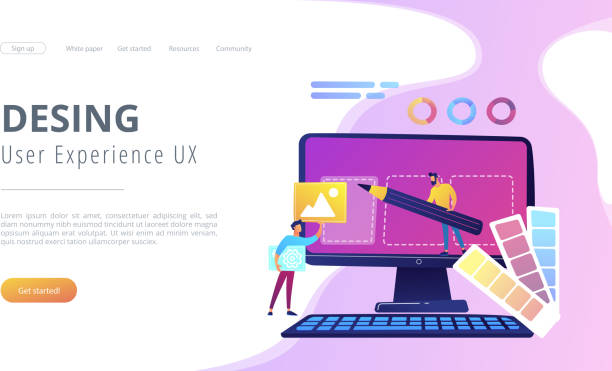An Introduction to the World of Responsive Website Design and its Necessity

In the current digital age, where users access the internet from a wide range of devices with varying screen dimensions, #responsive_website_design or Responsive Web Design is no longer a luxury option, but an undeniable necessity.
This approach in web design ensures that your website is displayed correctly and provides an optimal user experience, regardless of the device the user is employing – from a small smartphone to a medium tablet, laptop, or a large desktop monitor.
The main goal of implementing Responsive Website Design is to create a website with automatic adaptability to screen dimensions and device orientation.
This not only includes resizing visual elements like images and text, but also affects the overall page layout, menus, and navigation to make interaction with the website comfortable and intuitive for the user.
Constant changes in technology and the introduction of new devices have created unprecedented challenges for web developers.
Without Responsive Website Design, a website might display well on one device but appear completely unusable or disorganized on another.
This issue directly and negatively impacts user experience, bounce rate, and ultimately, the website’s business objectives.
A website that is not properly responsive can lead to the loss of potential visitors and customers.
Therefore, deep education and understanding of responsive design principles are vital for every web developer and online business owner.
This approach allows you to create a website that works well on all platforms with a single codebase, eliminating the need to develop separate versions for mobile and desktop, which is both time-consuming and costly.
In the remainder of this article, we will delve deeper into the concepts, techniques, and tools related to this engaging and crucial field, and clarify its importance from various angles, including technical, SEO, and user experience.
Understanding these principles will help you create more stable and user-friendly websites that maintain their position in the evolving world of the web.
Are you dissatisfied with the low conversion rate of visitors to customers on your e-commerce site?
Solve this problem forever with professional e-commerce website design by Rasaweb!
✅ Increase visitor-to-customer conversion rate
✅ Create an excellent user experience and build customer trust
⚡ Get free consultation
Why Responsive Design is No Longer an Option, but a Necessity?

In the last decade, we have witnessed a significant shift in how users access the internet.
Statistics show that over half of global web traffic originates from mobile devices, and this trend continues to grow.
In such a landscape, ignoring the need for a fully mobile-compatible website means losing a large segment of your audience.
This is where the #necessity_of_responsive_design becomes ever more apparent.
Google, as the world’s largest search engine, has emphasized the importance of #mobile_friendliness for years, and with the introduction of the #Mobile-First_Indexing algorithm, it officially announced that the mobile version of your website will be the primary basis for ranking and indexing.
This means that if your website does not provide a proper mobile user experience, you will have less chance of ranking high in search results, even if your content is of very high quality.
Beyond the SEO aspect, user experience (UX) also plays a pivotal role in a website’s success.
A non-responsive website on mobile devices can lead to severe user dissatisfaction.
The need to zoom in to read text, horizontal scrolling to see all content, or clicking on tiny links that are difficult to select, all contribute to increased bounce rates and decreased user engagement.
Today’s users are impatient and expect websites to work immediately and flawlessly on their preferred device.
#Responsive_website_design addresses this need, providing a seamless and enjoyable experience across all devices.
This not only increases customer loyalty but can also lead to improved conversion rates.
From a maintenance and development perspective, having a responsive website simplifies the work immensely.
Instead of maintaining multiple separate versions for different platforms (e.g., one site for desktop and a separate site for mobile), you have a single codebase that adapts itself as screen dimensions change.
This reduces development and maintenance costs and ensures that any content or design update is applied consistently across all devices.
For this reason, any business seeking sustainability and growth in the online space should prioritize the implementation of Responsive Website Design in its plans.
Fundamental Principles and Techniques in Responsive Website Design

To implement #responsive_website_design, there are three fundamental principles that every developer must master: #Media_Queries, #Flexible_Grids, and #Flexible_Images.
These three pillars form the core of #responsive_web and allow the website to intelligently adapt to various screen dimensions.
Media Queries are perhaps the most important tool in a responsive designer’s toolkit.
They allow you to apply different CSS styles based on device characteristics such as screen width, height, orientation (horizontal or vertical), and even resolution.
For instance, you can specify that for widths less than 768 pixels, the navigation menu transforms into a hamburger icon instead of a horizontal bar, or that fonts are displayed smaller.
This flexibility gives you precise control to optimize the user experience for every screen size.
Flexible Grids mean using relative units such as percentages (%) or em/rem instead of fixed pixel (px) units to define the width and height of page elements.
Thus, instead of a column having a fixed width, its width is adjusted based on a percentage of the available space.
This approach ensures that as the screen size changes, the page layout naturally contracts or expands, and content is proportionally placed within the available space.
Using this method is the foundation of sustainable Responsive Website Design.
Finally, Flexible Images ensure that images and videos do not overflow their containers or display too large.
This is typically achieved by setting the max-width: 100%; property for images in CSS, so that an image never exceeds its parent container but can scale down proportionally.
Furthermore, the use of the srcset attribute in the <img> tag and the <picture> tag allows developers to provide different images for various screen dimensions or resolutions, which significantly helps improve website performance and loading speed.
Mastery of these principles is the backbone of any successful Responsive Web Design project.
Comparison Table of Measurement Units in Responsive Web Design
| Unit Type | Description | Advantages | Disadvantages | Common Use |
|---|---|---|---|---|
| Pixel (px) | Absolute unit, related to screen resolution. | High precision, full control over dimensions. | Lack of flexibility in responsive design, poor scalability. | For borders, box-shadows, fixed lines. |
| Percentage (%) | Relative unit, based on the width or height of the parent element. | Fully responsive, maintains proportions across different sizes. | Less control over exact dimensions, can cause layout issues. | Column widths in layouts, image sizes. |
| em | Relative unit, based on the font size of the parent element (or the element itself). | Good scalability with font size, suitable for Typography. | Complex calculation if elements are nested. | Font size, padding, and margin of elements. |
| rem | Relative unit, based on the font size of the root element (html). | Good and predictable scalability, independent of parent elements. | Requires setting the root font size for overall control. | Font size, overall padding, and margin in a design system. |
| vw/vh | Relative unit, based on the viewport width and viewport height of the screen. | Direct control over viewport-related dimensions, excellent for full-screen design. | May scale excessively at very small or large dimensions. | Responsive font sizes, full-screen sections. |
Essential Tools for Responsive Website Developers

For any developer intending to work in the field of #responsive_website_design, understanding and utilizing the right tools is crucial.
These tools not only facilitate the development process but also help ensure the compatibility and correct functionality of the website across different devices.
Among the most important tools are CSS frameworks, preprocessors, and testing tools.
#CSS_frameworks like Bootstrap and Tailwind CSS have revolutionized how responsive websites are built.
Bootstrap is a comprehensive framework with predefined components for navigation, forms, buttons, and a 12-column grid system, all designed to be fully responsive.
Its use significantly reduces development time and ensures that your design is compatible across various browsers and devices.
On the other hand, Tailwind CSS is a Utility-First framework that allows you to apply styles directly in HTML using small, functional classes.
This approach provides more flexibility for designers and prevents the generation of excessive CSS.
In addition to frameworks, #CSS_preprocessors like Sass and Less are also powerful tools that enhance the process of writing styles by adding programming capabilities such as variables, functions (Mixins), and nesting to CSS.
These tools help with better code organization and reduce repetition, which is highly beneficial in large #responsive_web_design projects.
After development, the testing phase is of particular importance.
#Browser_Developer_Tools, built into browsers like Chrome, Firefox, and Edge, provide powerful utilities for simulating various devices and testing websites at different sizes.
Features such as Device Mode allow you to view the website at various dimensions and even simulate slow network connections.
Additionally, online tools like Responsive Design Checker or Google Mobile-Friendly Test help you quickly test your website across multiple dimensions and identify potential issues.
Ultimately, Responsive Website Design requires a comprehensive approach that includes selecting the right tools, writing optimized code, and thorough testing at various stages of development.
Do you have an e-commerce site, but your sales aren’t what you expect? Rasaweb solves your problem of low sales forever with professional e-commerce website design!
✅ Significant increase in conversion rates and sales
✅ Unparalleled user experience for your customers
⚡ Click to get free consultation from Rasaweb!
Common Challenges and Solutions in Implementing Responsive Design

Implementing #responsive_website_design, despite its numerous benefits, is not without challenges.
One of the biggest challenges is #website_performance_management.
When a website needs to perform well across a wide range of devices, from slow to high-speed network connections, performance optimization becomes crucial.
High-resolution images optimized for desktop displays can lead to slow page loading and high data consumption on mobile.
The solution to this problem is using flexible images with the srcset attribute and the <picture> element, which allow the browser to select the best image size based on screen dimensions and resolution.
Additionally, optimizing CSS and JavaScript, compressing files, and utilizing caching are essential for improving website loading speed across all devices.
Another challenge is #complex_layouts that require significant reorganization across different screen sizes.
For instance, a large data table that displays easily on a desktop might be unreadable on mobile.
For such cases, solutions like transforming the table into individual cards on mobile, or using CSS horizontal scrolling capabilities (overflow-x: auto;) can be beneficial.
Additionally, managing navigation on small devices is also a common challenge; traditional menus used on desktop occupy too much space on mobile.
Utilizing Hamburger Menus or a Bottom Bar navigation can improve the user experience on mobile.
Compatibility with older browsers has also always been a concern.
While modern browsers fully support CSS3 features like Flexbox and Grid, older browsers might require polyfills or fallbacks.
For example, you can use the @supports feature in CSS to provide different styles based on browser capabilities.
Ultimately, Responsive Website Design is an iterative process that requires continuous testing and adjustment.
By accurately identifying challenges and employing appropriate solutions, one can create a flexible and high-performing website that offers an enjoyable user experience on any device.
This intelligent approach ensures success in today’s competitive web world.
The Impact of Responsive Design on SEO and Website Ranking

In the competitive world of search engines, #SEO plays a vital role in a website’s visibility.
One of the most significant factors influencing SEO in recent years has been #responsive_website_design.
Google has repeatedly emphasized that websites optimized for mobile receive higher priority in search results.
This became even more crucial after the introduction of Google’s #Mobile-First_Indexing algorithm.
This algorithm means that Google’s bots first crawl and index the mobile version of your website, and then determine your website’s ranking based on that.
Therefore, if your website does not have a strong Responsive Website Design, its ranking in search results may decline, even if its content is of very high quality.
However, the impact of responsive design on SEO is not limited to Mobile-First Indexing.
Other factors are also directly influenced by responsiveness.
#Page_Load_Speed is one of the most important ranking factors.
A well-optimized responsive website (using optimized images, file compression, and minimizing server requests) provides a faster user experience.
This loading speed is not only important for users but is also considered a positive factor by search engines.
Furthermore, #reduced_bounce_rate and #increased_dwell_time, which are important indicators of user engagement, are directly affected by the quality of the user experience across different devices.
A responsive website that offers easy navigation and readable content on any screen size engages users more and increases their likelihood of returning.
These signals indicate to search engines that your website has more value for users, resulting in a better ranking.
Finally, having a single URL for all devices (as opposed to a separate m.example.com version) simplifies the crawling and indexing process for search engines and prevents duplicate content issues.
Therefore, every business and webmaster looking to improve their online visibility should include Responsive Website Design as a key strategy in their SEO plan.
Review of Successful and Unsuccessful Responsive Website Design Examples

To gain a deeper understanding of the #responsive_website_design concept, examining real-world examples, both successful and unsuccessful, can be highly illuminating.
Observing how these principles are implemented in practice helps us identify best practices and avoid common mistakes.
A #successful_responsive_website not only displays well across various screen sizes but also provides a seamless user experience.
For example, major websites like The New York Times or Apple are prominent examples of #responsive_design.
On these websites, layouts, font sizes, and images intelligently adjust as the browser resizes.
Navigation transforms from a horizontal menu on desktop to a hamburger menu on mobile, images are optimized for faster loading, and interactive features work well on every device.
These websites demonstrate how a single codebase can ensure accessibility and readability for millions of users with diverse devices.
In contrast, unsuccessful examples are typically websites that still use a fixed layout or whose #responsive_design has not been correctly implemented.
These websites on mobile may require frequent zooming, text may appear too small or too large, images may overflow their containers, or buttons and links may be so close together that clicking them is difficult.
Unfortunately, many older websites, especially in small businesses, still exhibit these issues.
Observing these examples highlights the importance of rebuilding and updating websites with a Responsive Website Design approach.
Some signs of a non-responsive website include:
- Requiring horizontal scrolling to view all content.
- Text that is too small and needs zooming.
- Images or videos that overflow their containers.
- Links and buttons that are too close together and difficult to select.
- Long loading times on mobile devices.
Ultimately, the goal of Responsive Website Design is to create a flawless user experience, not merely visual adaptation.
Learning from real examples is the best way to master this art and science, helping developers make smarter design decisions that benefit both users and the website’s business objectives.
Comparison Table of User Experience in Responsive and Non-Responsive Websites
| Feature | Responsive Website | Non-Responsive Website |
|---|---|---|
| Display on Various Devices | Automatic and optimized across all dimensions (mobile, tablet, desktop). | Fixed, requires zooming and horizontal scrolling on mobile. |
| User Experience (UX) | Enjoyable and friction-free, easy to use. | Difficult and frustrating, high bounce rate. |
| Management and Maintenance | Single codebase, easy updates. | Usually multiple codebases, more complex maintenance. |
| Effect on SEO | Positive, aligns with Google’s Mobile-First Indexing, improved ranking. | Negative, reduced ranking in mobile searches, Google penalty. |
| Loading Speed | Optimized for each device, usually faster. | Often slow on mobile due to desktop content loading. |
| Accessibility | Improved, high readability for all users. | Poor, especially for individuals with visual impairments. |
The Future of Web Design with a Focus on Advanced Responsiveness

The world of #web_design is constantly evolving, and with the advent of new technologies, the concept of #responsiveness is also developing.
The future of #responsive_website_design will go beyond merely adapting to screen dimensions and will move towards personalized and contextual user experiences.
Currently, we are witnessing new trends that are expanding the boundaries of responsive design.
One such trend is #Container_Queries, which allow developers to apply styles not based on the dimensions of the entire viewport, but based on the dimensions of an element’s parent container.
This capability provides unprecedented flexibility in designing reusable components, so that a component can display correctly in any container, without the need to define complex media queries for the entire page.
Furthermore, techniques like #Subgrid in CSS Grid are also under development, allowing us to create nested grids with responsive capabilities that align with the parent grid.
This helps in designing more complex and harmonious layouts.
The discussion of #adaptive_design also arises alongside responsiveness.
While #responsive_website_design means a fluid design that adjusts itself with changing screen dimensions, adaptive design typically involves a set of fixed layouts optimized for specific breakpoints.
The future will likely see a combination of both approaches, where websites not only react to screen size but also adapt to other factors such as device capabilities, network connection speed, and even user preferences (e.g., Dark Mode).
The emergence of Web Components and Single-Page Applications (SPAs) also impacts how Responsive Website Design is implemented.
These technologies allow developers to independently design smaller UI sections as responsive components that can then be used anywhere on the website.
Overall, the future of #web_design with a Responsive Website Design approach looks very bright and exciting.
We are moving towards a direction where websites are not only beautiful and efficient but also intelligently react to the needs and environment of their users.
These developments require developers to keep their knowledge up-to-date and always seek innovative solutions to create better web experiences.
Do visitors leave your e-commerce site before making a purchase? Worry no more! With Rasaweb’s professional e-commerce website design services, solve the problem of low visitor-to-customer conversion forever!
✅ Significant increase in conversion rates and sales
✅ Unparalleled and engaging user experience
⚡ Contact us now for a free consultation!
Key Tips for Choosing a Responsive Website Designer
![]()
Choosing a #responsive_website_designer or a professional design team is one of the most important decisions a business must make for a successful online presence.
Good #responsive_web_design is not just about visual appeal; it’s about efficiency, accessibility, and optimal performance across all devices.
Therefore, when making your choice, special attention should be paid to several key factors to ensure a sound investment.
The first and most important tip is to review their #portfolio.
Are the designer’s previous works websites that display well on mobile, tablet, and desktop? Test their websites across different browser dimensions and evaluate the user experience.
A skilled designer will showcase websites that are not only visually appealing but also technically flawless.
The second point is #technical_knowledge_and_expertise.
The designer should be well-versed in HTML5, CSS3 (especially Flexbox and Grid), JavaScript, and advanced media query concepts.
Additionally, familiarity with popular frameworks like Bootstrap or Tailwind CSS and CSS preprocessors like Sass indicates their up-to-date technical knowledge.
Ask them about their approach to #image_optimization and #loading_speed for responsive websites.
Third, #communication_and_transparency throughout the work process is crucial.
A good designer can explain technical concepts in simple language and keep you informed at every stage of the project.
They should have a clear understanding of your business goals and be able to align design solutions with these objectives.
Also, #post_delivery_support is very important.
Does the designer offer support and maintenance services after the project’s completion? Websites require continuous updates, and ensuring post-launch support is vital.
Finally, consider the cost_and_budget, but never sacrifice quality for a lower price.
A quality #responsive_website_design is a long-term investment for your business that can bring a significant return on investment.
By considering these tips, you can choose the right designer or team to implement your Responsive Website Design and take a firm step towards online success.
Conclusion and Final Outlook on Responsive Website Design

In this article, we comprehensively and deeply explored #responsive_website_design and understood why this approach has become an #undeniable_necessity in the current era.
From the widespread emergence of mobile devices and tablets to the increasing emphasis of search engines on mobile user experience, all indicate that #responsive_web_design is no longer an option, but the backbone of every modern and successful website.
We became familiar with the fundamental principles of this design, including #media_queries, #flexible_grids, and #flexible_images, and examined the essential tools developers need to implement it.
We also identified common challenges along this path and practical solutions to overcome them.
The profound impact of Responsive Website Design on #SEO and website rankings, directly tied to Google’s algorithms and user experience, further emphasized the importance of this topic.
By examining successful and unsuccessful examples, we learned valuable lessons and realized that mere visual adaptability is not enough; rather, a seamless and enjoyable user experience across all platforms must be achieved.
The future outlook also moves towards #advanced_responsiveness and #contextual_adaptation, with technologies like #Container_Queries that allow us even more precise control over how content is displayed.
Ultimately, choosing a #skilled_responsive_designer also plays a vital role in a project’s success and must be done with care and diligence.
Responsive Website Design is beyond a fleeting fashion trend; it’s a paradigm shift in how we build and interact with the web.
Given the continuous growth in the use of diverse devices and increasing user expectations, every business and developer must constantly update their knowledge and skills in this area.
Websites built today must not only meet current needs but also be adaptable to future technologies and devices.
Investing in a strong and efficient Responsive Website Design is an investment in the future of your business and guarantees effective communication with your audience in the digital world.
This approach forms the foundation for a sustainable and successful online presence and paves the way for future web innovations.
Frequently Asked Questions
| Question | Answer |
|---|---|
| What is Responsive Website Design? | Designing a website whose appearance and layout automatically adapt to the screen size of the user’s device (such as computer, tablet, mobile) to provide an optimal user experience. |
| Why is Responsive Design important? | Given the variety of devices users employ to view websites, responsive design improves user experience, reduces bounce rate, increases time spent on site, and enhances SEO. |
| What are the main principles of Responsive Design? | The three main principles include Fluid Grids, Flexible Images, and Media Queries. |
| What is a Media Query and what role does it play in Responsive Design? | A Media Query is a CSS capability that allows you to apply different styles based on display device characteristics such as screen width, height, resolution, and media type. This tool is considered the heart of responsive design. |
| What is the difference between Mobile First and Desktop First approaches in Responsive Design? | In the Mobile First approach, design and coding are initially done for smaller screens (mobile), and then styles are added for larger screens using media queries. In the Desktop First approach, the reverse is true; it is designed for desktop first and then adapted for smaller screens. The Mobile First approach is generally recommended. |
And other services of Rasaweb Advertising Agency in the field of advertising:
Smart Social Media: A professional solution to increase click-through rates with a focus on custom programming.
Smart Data Analysis: A fast and efficient solution to increase sales with a focus on attractive UI design.
Smart Data Analysis: A new service to increase website traffic by using real data.
Smart Digital Advertising: Designed for businesses seeking to attract customers through Google Ads management.
Smart Marketing Automation: A dedicated service for growing user engagement based on precise audience targeting.
And over a hundred other services in the field of internet advertising, advertising consultation, and organizational solutions
Internet Advertising | Advertising Strategy | Advertorials
References
Principles of Responsive DesignResponsive Design TutorialSEO and Responsive DesignFuture Web Design Trends
? With Rasaweb Afarin, take your business to digital heights and establish a powerful online presence tailored to today’s needs with our specialized services, including corporate website design. To learn more about our comprehensive digital marketing solutions, visit Rasaweb Afarin’s website.
📍 Tehran, Mirdamad Street, next to Bank Markazi, Kazeroon Janoubi Alley, Ramin Alley, No. 6


